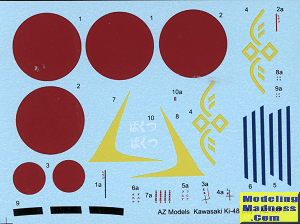
AZ Models 1/48 Ki-48-I 'Lily'
| KIT #: | AZ 4871 |
| PRICE: | $ |
| DECALS: | Three options |
| REVIEWER: | Scott Van Aken |
| NOTES: | 2009 initial tooling. This is the 2017 boxing. Includes Ki-148 missile |

| HISTORY |
The development of the aircraft began at the end of 1937 at the request of the Japanese military high command. Kawasaki received an order to develop a "high-speed bomber" capable of 480 km/h (300 mph) at 3,000 m (9,840 ft), and able to reach 5,000 m (16,400 ft) within 10 minutes. It was inspired by the Soviet Tupolev SB.
Kawasaki had the advantage of the experience of designing the Ki-45 twin-engined heavy fighter. Most technical problems were solved; however the aircraft had a number of shortcomings. It carried only an 800 kg (1,760 lb) bombload. This was actually more than contemporary light bombers such as the Bristol Blenheim or Tupolev SB, and only slightly less than light bombers designed several years later, such as the A-20 Havoc, and the strikingly similar-appearing Martin Maryland and Baltimore. Speed was intended to be its primary defense, much like the later, unarmed, De Havilland Mosquito. So it had only three machine guns (again, an equivalent armament to contemporary light bombers). This made it very vulnerable to enemy fighters later in the war, once they became fast enough to actually catch it. The flight characteristics of the Ki-48 also left much to be desired. Newer generations of Allied fighters caught up in speed, and eventually, the Ki-48 was too slow to outrun them, while superior modern Japanese aircraft, such as the Yokosuka P1Y and the Mitsubishi Ki-67, could only be produced in small numbers. The first versions were lightly armoured, so the Ki-48 was quite aerobatic, and could loop and turn with an experienced pilot at the controls. The aircraft was often used as a dive bomber in Burma. The aircraft was not necessarily a failure, and was considered an acceptable light bomber for the first few years of the war by many historians. Much like the Mitsubishi A6M Zero fighter, it was satisfactory for the period when it was designed and produced, but had to be used against much newer and faster competition, due to Japan's inability to produce enough newer aircraft.
| THE KIT |
 AZ Models initially released this kit in 2009. This is the 2017 release. You
may notice the correction set reviewed today. Well, I bought that because I
heard there were issues with the nose section. That is true if you have the
earlier releases. This one has that set included so if you have an early release
and want the correction set, let me know and we'll make a deal.
AZ Models initially released this kit in 2009. This is the 2017 release. You
may notice the correction set reviewed today. Well, I bought that because I
heard there were issues with the nose section. That is true if you have the
earlier releases. This one has that set included so if you have an early release
and want the correction set, let me know and we'll make a deal.
The kit itself is pretty much modern short run. It is superbly detailed on the outside. Transparencies are thicker than usual and not crystal clear. You will find some short ejector towers that will need to be removed prior to attaching many parts together (such as wings and tailplanes and fuselage). The kit does have a few resin pieces for the interior behind the pilots seat and there are a couple of photo etch bits for the lower fins on the missile. The missile is a stand alone model with a transport trolley as there is no rack for attaching it to the Ki-48. None of these were used in service.
One thing about AZ is that they give you a fairly good amount of detail. This is especially true of the interior. There are a lot of 'things' to fit on the interior floor and on the sidewalls of the fuselage. Enough to make the interior look pretty busy. Just about everything is butt joined, though placement markings are provided. There is no real main gear well detail as the openings are small enough that you won't see anything. This aircraft did not have main gear doors as you'd expect them with just a small cover for one of the landing gear legs. The wheel protruded out of the nacelle when retracted.
The engines are fairly well detailed and fit into
cowlings that are left and right sides. It appears that you can fix the seam
prior to installing the engine. The instructions are for both the Ki-48-I and
-II aircraft so the instructions have different sections and notes so you can
get those straight. When you attach the aft transparency you have the option of
having the rear section open or closed so you can have the rear machine gun
sticking out if you so wish.

Instructions are nicely done and provide notes and
generic painting information. Markings are provided for three planes. All of
them have a basic overall light grey with the first option being for the 45th
Sentai in  China
during 1941. Though shown with the yellow wing leading edges, this wasn't
required until late 1942 so I doubt it actually wore it. Second is one with a
green and brown upper scheme from the 8th Sentai in Burma in 1942. Note that it
does not have the yellow parts. Finally with a green mottle on upper surfaces
and a red rudder, a 75th Sentai plane in New Guinea during late 1943.
Decals look great and I expect they will be fairly thin. Color info on the back
of the box where the painting guide is located, are from Humbrol.
China
during 1941. Though shown with the yellow wing leading edges, this wasn't
required until late 1942 so I doubt it actually wore it. Second is one with a
green and brown upper scheme from the 8th Sentai in Burma in 1942. Note that it
does not have the yellow parts. Finally with a green mottle on upper surfaces
and a red rudder, a 75th Sentai plane in New Guinea during late 1943.
Decals look great and I expect they will be fairly thin. Color info on the back
of the box where the painting guide is located, are from Humbrol.
| CONCLUSIONS |
From what I have heard, this is not an easy kit to build. Not surprising as no AZ kit I've done from this time period has been, but it should make into a very nice model when you are done.
| REFERENCES |
https://en.wikipedia.org/wiki/Kawasaki_Ki-48
January 2021 Copyright ModelingMadness.com.
All rights reserved. Thanks to me for finding this one on sale, though I
forget the price as it took so long for the kit to reach me. If you would like your product reviewed fairly and
fairly quickly, please
contact
the editor
or see other details in the
Note to
Contributors.
Back to the Main Page
Back to the Review
Index Page
Back to the Previews Index Page